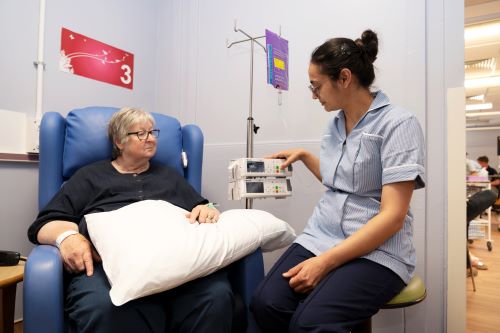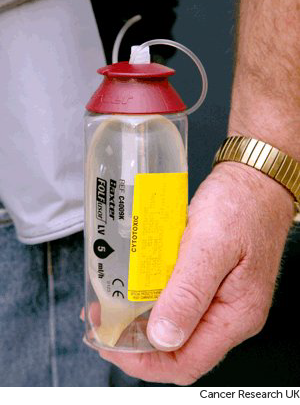Chemotherapy pumps
If you have chemotherapy into a vein, your nurse might attach a pump. This will give a controlled amount of drugs very slowly into your bloodstream. Chemotherapy pumps are also called infusion pumps.
There are different types of pump:
-
hospital pump
-
continuous pressure pump
-
battery operated pump
-
computerised ambulatory delivery device (CADD pump)
Hospital pump
If you’re staying in hospital for chemotherapy, you’ll have it through a pump attached to a drip stand. The drip stand is on wheels and the pump works on a battery so you can walk about with it.

Continuous pressure pump
A continuous pressure pump gives a low dose of chemotherapy 24 hours a day. It contains a small balloon, which contains the chemotherapy drug. This connects to your central line by a plastic tube. The chemotherapy flows from the balloon and into your vein. The balloon will slowly deflate as you have the chemotherapy.
The pump is about the size of a small water bottle and is fitted at the hospital. You can usually go home with it, and it doesn't need a battery. You can carry it in a bag or belt holster, which they'll give you at the hospital.
You go back to the hospital after a few days or a week to have the pump changed or removed. Or a district nurse may be able to change it in your home.

Battery operated pump
There are also small battery operated pumps. You can carry these around like the continuous pressure pumps. They are sometimes called ambulatory pumps. There are different types and your nurse will show you how to operate yours.
You might need to have your battery operated pump changed from time to time. You can go back to hospital for this. Or a home chemotherapy nurse or a district nurse may be able to change it at home.
CADD pump
A Computerised Ambulatory Delivery Device (CADD pump) is a battery operated pump. It is attached to a cassette or infusion bag that contains the chemotherapy. This then fits inside a bag that you wear like a rucksack or bag around your waist.
Your chemotherapy nurse programmes the pump. It delivers the correct dose of chemotherapy at the right time, as prescribed by the doctor.
The CADD pump allows you to have the treatment at home. Or you might stay in a hotel or other residence nearby, which the hospital pays for.
Looking after the pump
Your nurse will show you or a family member how to look after the pump. Contact your chemotherapy nurse if you have any problems or questions when you get home.
Talk to your doctor or specialist nurse if you’re nervous about being at home with the chemotherapy pump. Once your questions are answered, you might feel better about it.
Very rarely, chemotherapy pumps can leak. If you are having your chemotherapy at home, you might get a kit to use if this happens. Your chemotherapy nurse will give you instructions on how to use it.



